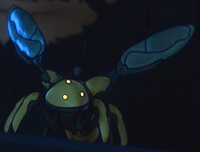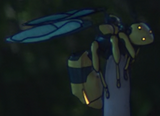Bionic hornet
The bionic hornet is a medium sized Antibug hunter bug machine fashioned after its biological blueprint.
History[edit | edit source]
Since the appearance of nanomachines on the battlefield it became necessary to counter them. As they are usually deployed in masses the arduous task of clean up could only efficiently managed by other nanomachines. The bionic dragonfly is only one such solution that also happens to be popular.
As versatile as it is its role covers many areas of small drones: patrol, surveillance, reconnaissance, firefighting, forward observer & fire director, search and rescue etc. The only downside to larger drones is due to mainly its size.
Design[edit | edit source]
The following is speculative scifi and not established canon!
- Lenght: 0.0 m
- Width: m
- Height: m
- Wingspan: 0. m
- Mass: 0.00 kg
As a mainly flying machine, the dragonfly is very light compared to landbased bugs. However, it's powerful enough to lift times its weight if necessary.
Communications and electronic countermeasure (ECM)[edit | edit source]
The dragonfly has a variety of communications devices.
- On its head it has 2 small (0.6-6Ghz) antennas.
Depending on the power of the transmission and the surrounding environment the effective range can be as far as 600m to as little as 10m. Likewise, the drain on the batteries may require a number of redundant units to cover an area at all times.
Sensors[edit | edit source]
The hornet possesses numerous camera eyes. The multispectral photonic cameras require very little power. The main cameras serves for collecting intelligence, video recording as well as for operator operation if needed. The auxiliary camera primary serve for navigation, obstacle recognition and defense surveillance. The photonic elements are not effected by EMP.
- The head has 2 main cameras: 0.0015 W
- resolution: high
- modes: daylight; night vision; IR or thermal
- There are 4 auxiliary cameras on various location on the body: 0.00025 W
- resolution: low to medium
- modes: daylight; IR or thermal
Mobility[edit | edit source]
The hornet possesses the ability to move on land, fly in the air and swim on water. It features 6 legs which allows it to move at a speed of up to 7 km/h on land; jump as high as 0.05m and swim(paddle) up to 0.05 km/h. The bug cannot dive but can be submerge up to 5m without damage.
It has two wings. It can fly at a speed of up to km/h at an altitude above ground of up to 300 m. The maximum altitude for safe 100% flight capability is up to m. The "muscle" power is provided by an actuator fluid powered by electricity. The fluid serves as pneumatic muscle. It acts as a natural cooling fluid, too.
Body and wings[edit | edit source]
The body structure is made up of shape memory superelastic alloys (SMA) and energy-absorbing protein-based material (TSAM). These offer lightweight, breathability for cooling, stiffness, durability, impact and deformation resistance and absorption. It's tough enough to resist biological predator attacks and crashes.
The shell armor consist of up to 0 mm thick SMA backed by TSAM. The SMA of the shell is non-magnetic and has low radar signature. The shell has cerakote coating applied as long-term protection against UV rays, dust, dirt and water. The side and top antennas aren't covered by the SMA.
The wings have shape memory alloys which reduces vibration allowing them to remain more effective than naturally possible. The wings feature single photon solar cells membranes with an efficiency of 99%. At full packed coverage the solar cell layer area becomes a pure black hue, hence, the cells are spaced enough to remain transparent. As such the coverage drops to 40%.
Batteries[edit | edit source]
The hornet features 3 separate batteries for a number of reasons: easy management, different integration purposes
- Common operation battery, carbon nanotube (CNT) based high capacity version
- for operating the computer system and the sensors
- is designed as part of the structure
- Primary operation battery, gel based high power
- for operating the flight system and mobility
- is designed as part of the cooling system; serving as a heat sink
- Secondary operation battery, carbon nanotube (CNT) based high capacity version
- for supporting the primary battery and providing capacity; mainly charging it
- is designed as part of the cooling system; serving as a heat spreader
Computer[edit | edit source]
The bug has a photonic computer system. It's not effected by EMP.
Weapons[edit | edit source]
Jaw[edit | edit source]
The dragonfly has specially designed mandibles or jaws which can exert up to N of biting force. This is used as defense against natural predators as well as a tool for cracking other bug's armor.
Sting[edit | edit source]
Picture Gallery[edit | edit source]
See also[edit | edit source]




